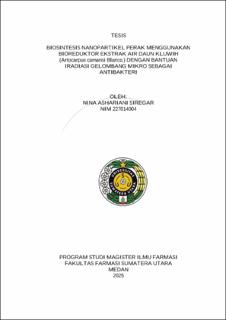| dc.description.abstract | Silver nanoparticles are particles smaller than 100 nanometers that can be synthesized from silver metal using physical, chemical, and biological methods. However, plant-based synthesis of silver nanoparticles is more widely used because it is simpler and more environmentally friendly. Kluwih leaf aqueous extract (Artocarpus camansi Blanco.) is known to contain secondary metabolites such as alkaloids, flavonoids, phenols, saponins, and glycosides, which act as bioreductants in the formation of silver nanoparticles (AgNPs). In the synthesis process, microwave irradiation is employed to accelerate the reaction rate during the formation of silver nanoparticles. This study aims to synthesize silver nanoparticles using kluwih leaf aqueous extract as a bioreductor, characterize them, and evaluate their antibacterial activity against Staphylococcus epidermidis and Pseudomonas aeruginosa.
The dried plant material (simplisia) was extracted using the decoction method for 30 minutes at 90°C. Kluwih leaf aqueous extract was added to the AgNO3 solution to reduce silver ions into silver nanoparticles, by microwave irradiation at 450 Watts for three minutes. The silver nanoparticles were characterized using ultraviolet-visible, FTIR, PSA, zeta potential, SEM-EDX, TEM, XRD, and tested for stability with ultraviolet-visible and antibacterial activity using the microdilution method.
Phytochemical screening revealed that the kluwih leaf aqueous extract (EADK) is effective as both an antibacterial agent and a reducing agent for AgNPs. The ultraviolet-visible spectrophotometer results for AgNPs showed a maximum peak at 424 nm. FTIR characterization indicated a decrease in intensity and a shift in the position of the -OH group, suggesting that the -OH groups from the plant played an active role in the silver nanoparticle formation process. PSA and zeta potential measurements showed an average particle size of 42.13 nm and a zeta potential of -43.8 mV. SEM and TEM analyses revealed spherical particles with diameters of 34.21 ± 14.21 nm and 18.84 ± 10.36 nm, respectively. XRD analysis revealed a Face-Centered Cubic (FCC) crystal structure. Moreover, AgNPs-kluwih exhibited strong antibacterial activity against Staphylococcus epidermidis, with MIC values of 1.9 and MBC values of 3.8 µg/ml, respectively, as well as against Pseudomonas aeruginosa, with MIC values of 7.8 µg/ml and MBC values of 15.6 µg/ml.
The results of the study indicate that kluwih leaf aqueous extract (Artocarpus camansi Blanco.) serves as an effective bioreductor in reducing silver ions (Ag⁺) into silver nanoparticles (AgNPs). Additionally, AgNPs-kluwih exhibits antibacterial activity against Staphylococcus epidermidis and Pseudomonas aeruginosa. | en_US |


